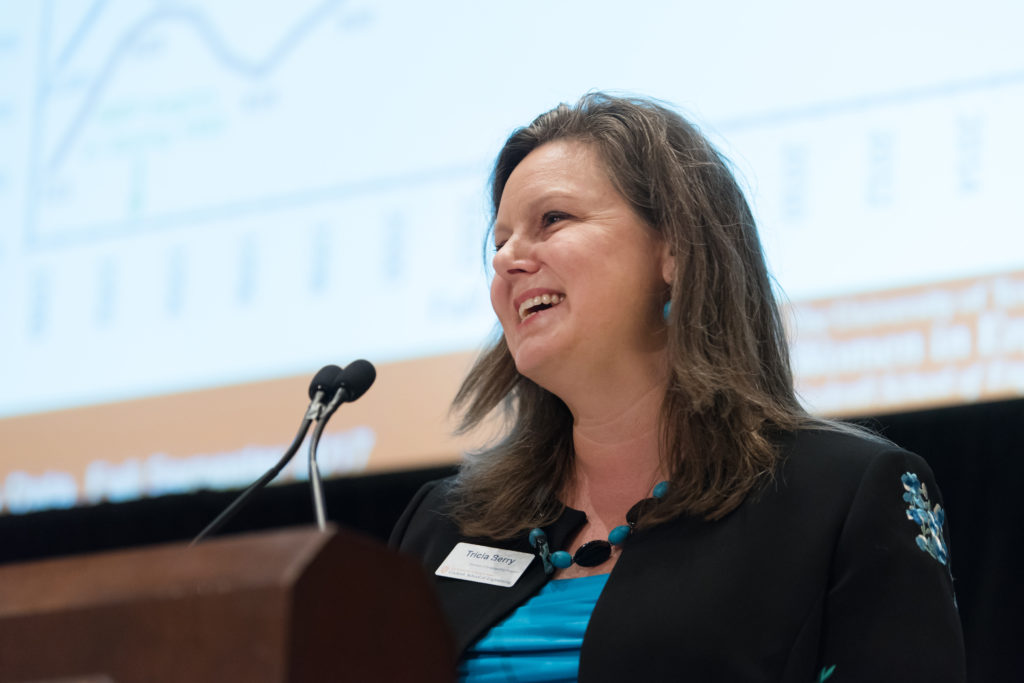Tricia Berry is raising the bar for women in STEM.
By Jessica Luther, Photo courtesy of UT Women in Engineering

Tricia Berry spends her days trying to make the engineering world a more inclusive place for women. As the director of the Women in Engineering Program at the University of Texas, she works to match the population in the state of Texas with the university’s enrollment.
“We would love to have our undergraduate- and graduate-student enrollment be 50 percent women,” she says.
Currently, 29 percent of the university’s engineering undergraduates are women and only 22 percent of its engineering graduate students are women. In the hopes of changing those statistics, Berry is active on social media, manages alumni and volunteer relations, and administers a whole host of events, including Women in Engineering’s annual Introduce a Girl to Engineering Day and various summer camps. Berry recently brought in alumni who are using their engineering degrees in the business world to, as she says, “connect with our current engineering students to show them that as a pathway.”
With 7,700 engineering students and more than 50,000 students total on the UT campus, Women in Engineering representatives do their part to reach out to students who seem like they are struggling.
“Sometimes, for these students,” Berry says, “especially female students…[they]feel isolated and alone or like they’re the only one that’s failing. We’re trying to help them and support them all the way through.”
Women in Engineering is comprehensive in its approach, with Berry and others recognizing getting girls interested in science, technology, engineering and mathematics begins well before they ever get to campus. And staying connected after they’ve gotten their degrees can be a challenge.
“We are doing things in the precollege space, trying to get more girls interested,” Berry says. “We’re doing things in the retention space, trying to keep them once they are enrolled. We are trying to do things in the career-development space to help them be successful when they get out into the workforce. It’s kind of all the way through that we’re trying to…keep them connected and engaged.”
As part of her work, Berry also leads the Texas Girls Collaborative Project, which plans workshops, engages in outreach for students in kindergarten through 12th grade and provides resources for adults wanting to get girls involved with STEM education. The project is run through Women in Engineering, which serves as the “physical agent” that keeps the project’s initiatives moving forward.
Berry understands the importance of giving girls the chance to experience STEM when they are young. In high school, Berry attended a weeklong summer camp at Southern Illinois University, where she fell in love with engineering. She later attended the University of Texas and graduated with a degree in chemical engineering.
After spending some time working in the industry, she returned to her alma mater in 1999 to become the director of the engineering scholarship program. In 2001, she took on her current position with Women in Engineering.
Her hope is that a program like Women in Engineering will not be necessary in the future.
“I really would like us to not need to exist,” Berry says. “I’d love it to be where not only [women make up]50 percent…but we’re inclusive and have an environment where all of our students are welcomed and feel valued and confident in their abilities.”
After 16 years leading the Women in Engineering Program, Berry continues to see change.
“I think as more of our women get out there and have that confidence, they’ll force those changes to happen,” she says. “We’re starting to see some of that happen now. I think that’s exciting.”


